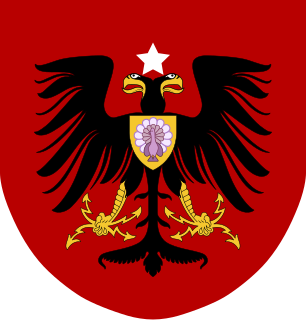Gerlach is a male forename of Germanic origin, variations of which exist in many Germanic and Romance languages. Like many other early Germanic names, it is dithematic, consisting of two meaningful constituents put together. In this case, those constituents are ger and /la:k /. The meaning of the name is thus 'spear thrower'.
It became a surname, and a source from which other surnames have been derived, as well.

Isenburg was a region of Germany located in southern present-day Hesse, located in territories north and south of Frankfurt. The states of Isenburg emerged from the Niederlahngau, which partitioned in 1137 into Isenburg-Isenburg and Isenburg-Limburg-Covern. These countships were partitioned between themselves many times over the next 700 years.
Wied was a County of Rhineland-Palatinate, Germany, located on the river Wied where it meets the Rhine. Wied emerged as a County earlier than many other German states. From 1243–1462, Wied was united with an Isenburgian County as Isenburg-Wied. Wied was partitioned twice: between itself and Wied-Dierdorf in 1631, and between Wied-Neuwied and Wied-Runkel in 1698. Via William of Albania, the House of Wied ruled the Principality of Albania in 1914.
Nieder-Isenburg was a small mediaeval County in northern Rhineland-Palatinate, Germany. It was located to the east of the town of Neuwied, due north of Vallendar.
Isenburg-Kempenich was the name of a state of the Holy Roman Empire, based around Kempenich in modern Rhineland-Palatinate, Germany.
Isenburg-Arnfels was the name of a state of the Holy Roman Empire, located in the Bad Hönningen area in modern Rhineland-Palatinate, Germany.
Gerlach II of Isenburg-Arnfels was the Count of Isenburg-Arnfels from 1333 until 1379. After his death, the line of counts of Arnfels was extinct, so the lands were inherited by Isenburg-Wied.
Isenburg-Braunsberg was the name of a state of the Holy Roman Empire, based around Braunsberg in modern Rhineland-Palatinate, Germany. It was created as a partition of Isenburg-Isenburg in 1199 (1210). In 1338 Isenburg-Braunsberg became an Imperial County. It slowly acquired territories of the County of Wied, being renamed to Isenburg-Wied in 1388.
William II of Isenburg-Wied was the Count of Isenburg-Braunsberg from 1383 until 1388, and the Count of Isenburg-Wied from 1388 until 1409. William renamed his state Isenburg-Wied in 1388.
Gerlach I of Isenburg-Wied was the Count of Isenburg-Wied from 1409 until 1413.
William III of Isenburg-Wied was the Count of Isenburg-Wied from 1413 until 1462.
Friedrich Wilhelm, Prince of Wied was the son of Hereditary Prince Hermann of Wied and Countess Marie Antonia of Stolberg-Wernigerode; and grandson of William Frederick, 6th Prince of Wied. He was the titular Prince of Wied from 1945 until his death.
Carl, Prince of Wied was the second son of Frederick William, 7th Prince of Wied (1931–2000). In 2000, he succeeded his father and became the titular 8th Prince of Wied.
Princess Guda of Waldeck and Pyrmont is the youngest daughter of Josias, Hereditary Prince of Waldeck and Pyrmont, head of the House of Waldeck and Pyrmont from 1946 to 1967 and first wife of Frederick William, Prince of Wied.
Johanna Sibylla of Hanau-Lichtenberg was the first child of Philipp V, Count of Hanau-Lichtenberg from his first marriage with Countess Ludowika Margaretha of Zweibrücken-Bitsch (1540-1569).

The House of Vidi or House of Wied is a European dynasty founded by William, Prince of Albania, who reigned briefly as sovereign of the Principality of Albania as Vidi I from 7 March 1914 to 3 September 1914, when he left for exile. His reign officially came to an end on 31 January 1925, when the country was declared an Albanian Republic.

Runkel Castle, a ruined hill castle from the High Middle Ages, is located in the city of Runkel in the Landkreis Limburg-Weilburg in the state of Hesse, Germany.
Princess Isabelle of Wied previously Princess of Isenburg is third child and second daughter of Franz Alexander, Prince of Isenburg, head of the mediatized House of Isenburg and his wife, Countess Christine von Saurma-Jelltsch. By marriage Princess Isabelle was the wife of the Head of the House of Wied-Neuwied. Once widowed that position went to her eldest son Maximilian, 9th Prince of Wied.
This page is based on this
Wikipedia article Text is available under the
CC BY-SA 4.0 license; additional terms may apply.
Images, videos and audio are available under their respective licenses.


